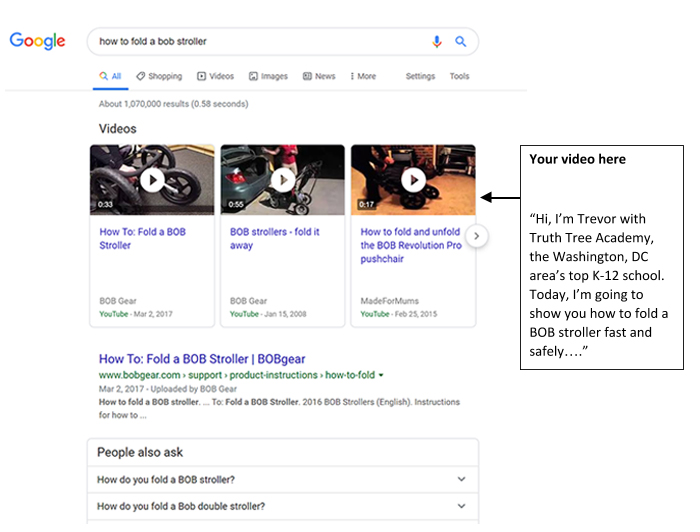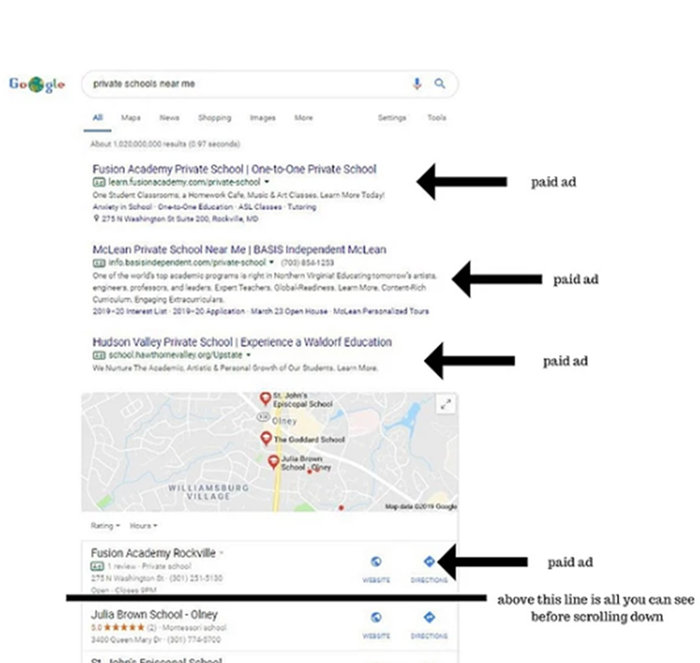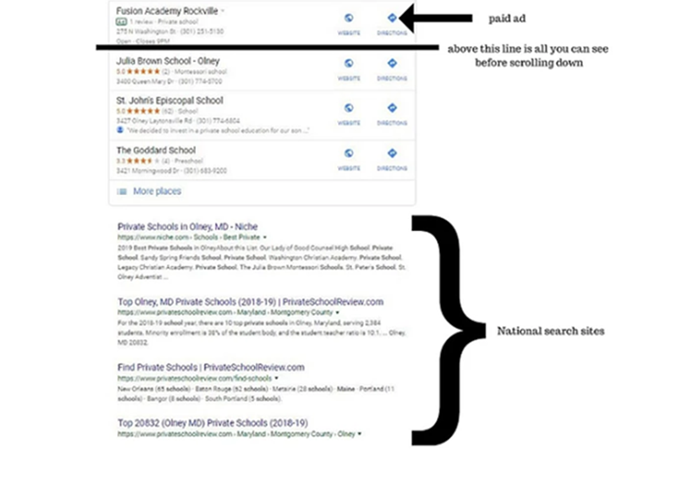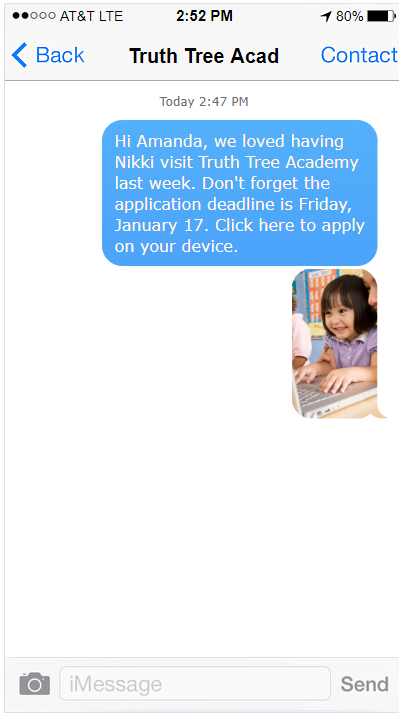It will be the decade that artificial intelligence takes center stage in how we operate our schools. From hiring to firing, to project bidding and fundraising, an AI platform will predict a looming problem, solve it, and let you know about the predictive outcome. I touch on what this will look like for marketing and admission folks in a blog I wrote one year ago.
But until Skynet takes over your marketing and admissions office, recruiting and retaining mission-appropriate students, the buck stops with you to get their attention, build trust and rapport, compel them to take action, and maintain the highest level of value. And the way you do that is through their devices and the platforms they frequent on those devices.
I’m not going to cover every inch of digital marketing in this article. What I will provide are some tips, hacks, and trends so you can stop managing enrollment and start designing it for a prosperous decade.
Create Compelling Content
If you are going to get the attention of potential families, you must do it BEFORE they need you. To accomplish this, you should know what they want, need, and value. Here are three tips on how to create such content and how to deliver it to the right people.
- Show Off Your Expertise
You work in education, so you should have some level of expertise in, well, education. Recently, Google has been putting more emphasis on “quality content from reliable sources” as a ranking signal. So, if you or someone at your school is an expert in a particular area or discipline (the niche-ier the better), write or vlog about it. But great content won’t stand on its own. Once created, it’s important to ensure people will see it. This is where proper tagging and building powerful backlinks will advance your search engine optimization (SEO). Plus, if the content is compelling enough, give it a pay-per-click push via search engine marketing (SEM) and social media marketing (SMM). - Depth > Breadth
Dovetailing off the above tip, experts write “quality content” —long, detailed pieces rich with research. Now, in the past, I’ve pushed heavy on the breadth and light on the depth since people don’t have time or attention span to read a 10-minute blog on the advantages of spiraling curriculum. However, Google is tired of quick-hit jobs simply in the name of site traffic, so higher organic rankings will go to content that displays the highest quality. - Specialty Videos (SMM & SEO)
I’ve been harping on this for a few years now. Your 4-minute school promo video and a few concert videos are not what people are looking for. You need to have content that provides value for prospective and current families, can be easily searched for, and be optimized for the platform it runs on. Why? Because Cisco says, online video will make up 80% of all online traffic by 2021.
Let’s say that you are a K–12 school trying to ensure you have a robust enrollment from the get-go. How could you ensure right-fit families know about your school? Get niche-y with it! What does every affluent parent need for their child? A BOB stroller, of course, but those things are so hard to fold. Oh wait:
Practically Speaking
What you say is important. It’s now a storyteller’s world, and the best storytellers are going to get the most interest in their school, but where, when, and how you tell your school’s story is important too. Here are some tips on how to deliver your compelling story to the right people at the right time. - SEM > SEO
Despite the push to get your SEO in the right place as I did above, I firmly believe that in a get-it-now world, you need to show up above the fold in any search. If you are focusing on SEO alone, that is not going to happen.
For example, I just ran a search for “private schools near me,” the first organic, single listing school result was the 12th snippet. Even the most optimized school website is not going to surpass the paid ads, national search sites, or articles written about private schools in widely read news outlets.
Sorry for making you squint, but two full scrolls it took to get to an optimized organic result.

- Match Game
When it comes to the language you use, unique is not good. Yes, you want your school to stand out from the crowd with amazing school communications and school public relations, but if the crowd is searching online for a “private elementary school” and you refer to yourself as an “independent school” and grades K–5 as your “lower school,” then the internet is not going to like you, and people won’t find you. The less comparable your keywords and ads are to the content on your landing page and site, the more money it will cost to get a high-valued placement. - Start with SEM, finish with SMM
When parents start searching for independent schools, 90% of them start on Google, according to Junto. Now, you know, and I know what sites parents eventually find and use—Niche and Private School Review, to name two—but parents new to the process don’t know that. So, unless they are in the 10%, your first impression will be made on a Google search.
Depending on what you consider to be your admission season, put more money behind search ads early, and shift more of your digital spend to social media and display-based marketing along with more compelling calls to action. By then they know who you are and hopefully understand what you can offer their child. But even if it’s a good match, people still need a push and a reminder. I mean, just think of the things you’ve purchased after “window shopping” on Amazon and seeing it advertised on other sites’ ad bars day after day. We suggest you give School Webmasters a call if you need help with the social media side of things. Their terrific Social4Schools packages may be just what you need.
IF IT SOUNDS CREEPY, IT’S ACCEPTABLE NOW
We in the independent school world have cringed at the idea of using “fringe” tactics to get people to take notice. I remember in 2008 at the school I worked at, the marketing committee decided lawn signs would be an excellent way to promote an open house. As head of marketing at the time, boy did I get a lot of flack from current families, ‘Only plumbers and sleazy sales people put signs by the side of the road. This is beneath a private school.’ - Text Me
92% of the US population owns a mobile device capable of receiving text messages. Wow!
90% of text messages are opened within the first three minutes. Double Wow!!
You are likely familiar with text marketing or SMS marketing. While most of the ones I get are from complete spammers, the ones I get from organizations and entities I know do get my attention. But I’m just one person. What about everyone else? According to Blue Compass, 63% of the US population sees texting as a “private experience,” but 83% of the same population prefers to get “important” information via text. And what is more important than their child’s education?
Plus, you don’t have to worry about getting through spam filters or emails getting thrown in the social or promotional folder. And no more voicemails going unheard because the person doesn’t know how to access their vmail anymore—seriously, who still leaves messages?
- Get the MAID to do it
MAID stands for Mobile Advertising ID. MAIDs are essentially like a cookie for your phone that allows advertisers to not only know what you are doing on your phone but where you are doing it. Plus, unlike home computers and desktops that get used by multiple people in the family, typically, mobile devices are for one person. Also, information from a device gives you a clearer picture because we use our phones for work, email, social engagement, texting…everything! Oh, and in 2015, internet use by mobile devices surpassed all other forms combined, so…
So, you are looking for the elusive, full pay families that live by the bay. Well, it just so happens the 17th Annual Pre-Teen Regatta is coming up. With MAIDs technology, you can tag the marina and everyone who comes inside of it during the Regatta. Any active mobile device in the area can be tagged and fed ad-based information from then on. It’s a powerful way to target. - Talk to me, Goose!
If you follow me on LinkedIn or have spent 5 minutes talking shop, you know I’m bullish on capturing your voice-first real estate on Alexa and Google Home Assistant. There are two avenues schools can take great advantage of voice-first tech for free or next to nothing. The first is, create content and brand it.
You: Hey Alexa, what’s a good way to remember the noble gases on the periodic table.
Alexa: Here’s Truth Tree Academy science teacher, Trevor Waddington, with a great mnemonic device to remember the noble gases…
Or, if you want to be more practical, you can create a flash briefing for your school.
You: Hey Google, open Truth Tree Academy.
Google Home Assistant: Welcome to Truth Tree Academy, what would you like to do today? You can choose from the following, today’s news, lunch menu for the week, or sports schedule.
The decade is already underway, and the coming avalanche of new tech to help your school thrive is already out there. My advice, take the one you think will have the biggest impact at your school and dive in deep.
By Trevor Waddington, Truth Tree Academy CEO


